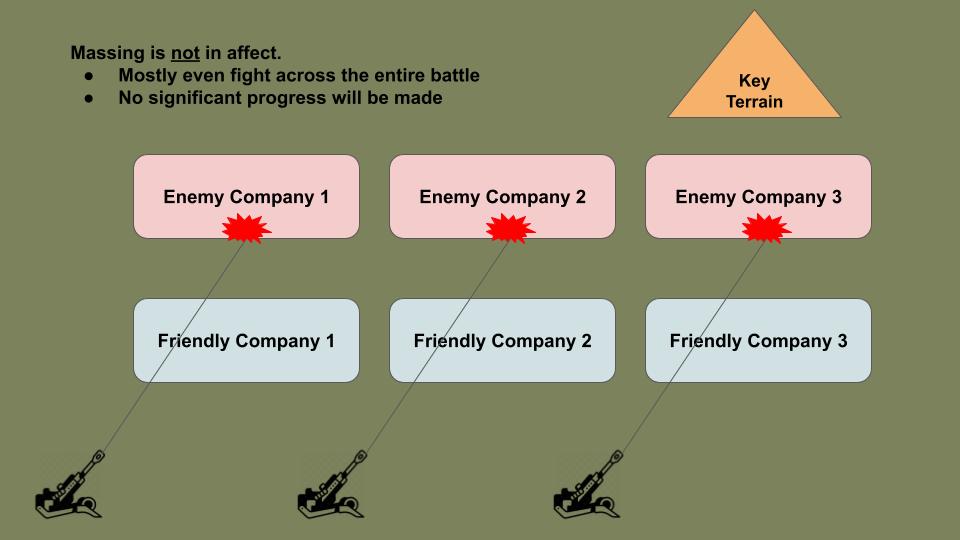Summery:
-
The principle of massing is to concentrate as much of your resources as possible on a decisive point to give yourself an overall advantage over your competition.
-
This means limiting resources going to other areas that could use them.
-
If you had to win in one area, which one would give you the biggest advantage over your competition? You would then mass as much as you can there.
WAR
MCWP 3-10 MAGTF Ground Operations defines massing as:
The purpose of mass is to concentrate the effects of combat power at the most advantageous place and time to produce decisive results. In order to achieve mass, appropriate joint force capabilities are integrated and synchronized where they may have a decisive effect quickly. Mass must be sustained to have the desired effect.
In simple terms, massing is putting everything you’ve got, into whatever advantage you have at that time. When you do this it will take a fair fight and make it an unfair fight. You want unfair fights.
During war, massing generally refers to focusing artillery, mortars and air into a single place to break an infantry unit through. Once that point has been broken through, it can be exploited.
The following example will be helpful.
Imagine you’re an infantry battalion commander with three infantry companies. All three companies are heavily engaged by the enemy. Each is in trouble and is requesting help from artillery fires.
You have a choice.
You can spread your artillery across all three companies so they each get a little help, or you can concentrate your fires on one company and help them win their fight.
In the below graphic you can see a simple depiction of artillery being spread out. Each friendly company is engaged with a single enemy company. The artillery is evenly distributed with one being fired at each enemy company. The key terrain is representing a hill that will give an advantage to anyone who owns it. With the fires not being concentrated the fight is mostly even with no significant advantage for any friendly company.

The principle of massing makes the decision clear. The company that would give the entire battalion the biggest advantage if they broke through, should get as much of the artillery as they need to win. The other companies will have to deal with getting no artillery support, or very little, depending on how much the priority company needs.
The next graphic depicts massing all of the artillery onto Enemy Company 3. This will give Friendly Company 3 a huge advantage. That advantage should give them the best chance to take the key terrain.
The priority company usually would be the one that is closest to key terrain or a key objective. If the artillery helps them occupy it would turn the advantage of the entire fight, giving the entire battalion a chance to win.

This is a very simplified example of the two extremes; the artillery being evening spread out and the artillery being massed completely on one enemy unit.
Once massed you are taking a lot of risk.
It is a painful choice
This decision to mass will not be easy.
- What if the commander chooses the wrong company and massing fires doesn’t break them through, wasting the effort?
- What if they mass the fires too much and the other companies get overrun, causing a huge disadvantage in another location?
Massing will always be a tough call that takes boldness and courage to make. The commander will be diverting resources away from units who are in a fight for their lives.
However, the principle dictates that more people will die if the priority team isn’t successful.
It won’t always be one or the other. You often have enough artillery to give one company enough, while also helping the others. A leader’s job is to maximize the effectiveness of their resources.
BUSINESS
Massing is very applicable to the business world.
If you’re a business leader, ask yourself:
- If we had to win in one area, which one would give us the biggest advantage over our competition?
- Your answer to that question is where you should mass as much money and people as possible.
It is very difficult to prioritize and allocate scarce resources. Everyone on your team has a good reason for needing more money and people.
As a leader you must communicate what your highest priority team is and mass your resources there. Once that team has been appropriately resourced, you can then start diverting resources to other parts of the business. I define “Appropriately resourced” as, when the team is staffed and funded to the point that it is getting diminishing returns by adding more, or that you are confident in their success.

All non-priority teams must live with being lean. That expectation must be very clearly communicated to them. They need to understand why they aren’t getting the funding and people they are requesting.
When people know that they aren’t getting any more help, they can get scrapy. If they think help might be coming, they will usually drag their feet waiting for it. Make sure they know they have to make do with what they’ve got, while the priority team is working to break through.
Massing on the correct opportunity is the key to success. The leader needs to make the best decision at that moment. The better analysis and inputs you have, the better decision you’re likely to make.
Key Takeaways:
- Give your priority team everything they need to be successful.
- Inform the non-priority teams that they aren’t getting anything more and to get scrappy.
References:
Headquarters United States Marine Corps. 2018, April. MCWP 3-10 MAGTF Ground Operations. Link

0 Comments